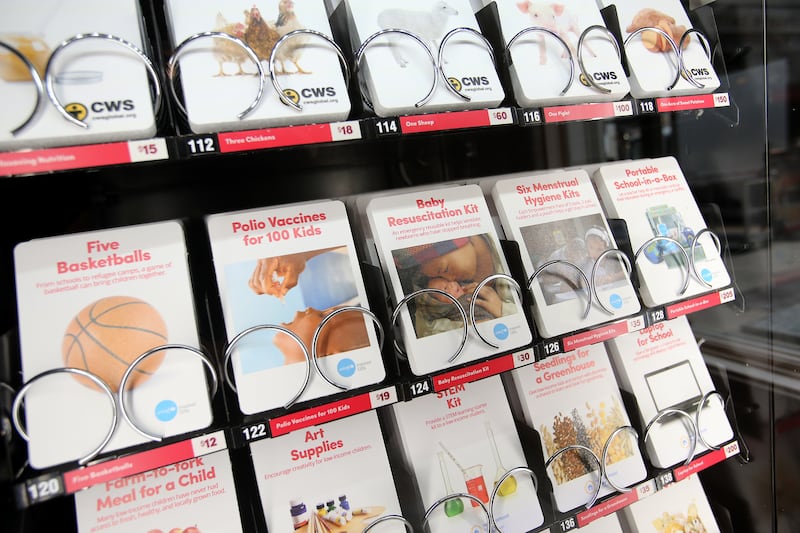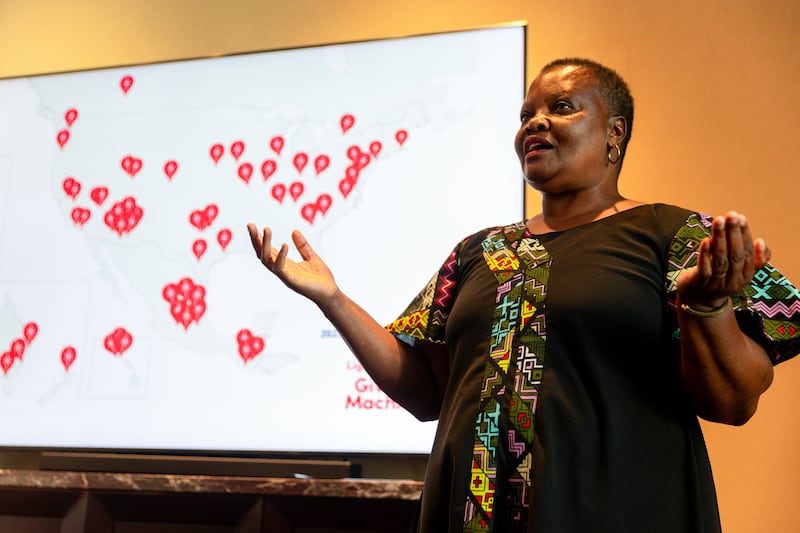If you like to buy baby chicks for charity at the big red vending machines during the holiday season, here’s the rest of the story about the good they do.
In 2020, Church World Service Africa took some of the money for baby chick donations made at the Light the World Giving Machines and used it to give three chicks each to 90 women in a village in Muganza, Tanzania.
Then the pandemic hit and world service officials couldn’t monitor progress. When the travel restrictions lifted, the charity’s leaders returned to the village in January 2022. What they found buckled their knees. The women had turned those 270 2-month-old chicks into 5,000 chickens.
The livestock was changing their lives in profound ways. In addition to their economic prospects, ownership of chickens, goats and piglets elevates respect for these women.
There’s more — a Church World Service Africa official told the women in the village that she would double down on the investment in them made by those who fed money into to the Giving Machines.
“You will be our new supplier,” said Mary Obiero, director of relief development and protection. “I need 7,000 chickens next year.”

This summer, the women supplied 7,223 chickens to CWSA and took home $30,000.
“They are rich women now,” Obiero said. “They are respected women. Everyone is coming to them for advice.”
The three-year partnership with the Giving Machines has allowed Church World Service to help 20,000 small farmers in Africa, Obiero said. Over 70% of them are women.
She likes to call it the Chicken Movement.
Based in Nairobi, Kenya, Obiero recently flew to the United States to talk about the success of the Light the World Giving Machines, which are sponsored by The Church of Jesus Christ of Latter-day Saints.
“It’s a great idea,” she said. “I have been in the community development business for almost 30 years, but I’ve never seen the quick and massive impact like I’ve seen with the Giving Machines. The improved breeds of chickens, piglets and goats and the modern beehives that they’re giving out produce results very, very quickly.”
How the Giving Machines are amplifying women’s voices in Africa
“I feel very touched because as an educated women in Africa, my desire, my passion is to make every woman comfortable. This particular project is helping me to do that,” Obiero said.
Women in many villages have never owned a single thing in their lives, she said, and live completely at the mercy of their husbands. They also, she said, are looked down upon because they often are less educated, don’t have their own resources to add to the family budget.
Before the Giving Machines donations, the women in Muganza had to ask their husbands for money when the family ran out of food. They were dumbfounded that the Giving Machines project put chickens in women’s hands, Obiero said. They were determined to multiply the chickens because of what it meant for their daughters.
“This particular program has actually brought about social transformation, for communities, for families, and more importantly, for women and girls,” Obiero said.
“A woman who has 10 chickens laying 10 eggs a day is able to sell the eggs and send her daughter to school. You may not have realized when you are giving chicks that the chicken’s eggs can actually keep someone in school and they can be able to finish school.”
Owning livestock also fostered respect for these women.
“Usually, if there’s livestock in the home, the woman will take care of the livestock, but they don’t have control and they cannot make a decision,” Obiero said. “So we give goats and chicken and piglets to the women, and for the first time the women are able to sit together with the men and talk about livestock, something that would never happened before.”
She said some men have been grateful for the change.
“This project has brought love and unity in our families, because we have reached a point where we are looking at our wives as our soulmates, people who can sit and have a discussion with us,” they tell Obiero.
“The Giving Machines have created gender equity among the communities where we work,” she said.

The Chicken Movement includes goats, beehives and piglets
The 90 women in Muganza are entrepreneurs. They work in three farmer groups. CWSA has selected some of them to then train other trainers to go out and help farmers duplicate their success.
“They are growing a chicken enterprise, a business,” Obiero said. “They have opened up a shop. They sell chicken feed. They sell chicks. They sell chicken medicine in the village.
“I visited Tanzania a week ago and the 7,000 chickens the women supplied have been distributed to others and are laying eggs,” she said. “About 6,000 are hens and 1,000 are roosters. The 6,000 hens are going to lay 6,000 eggs every day. Just calculate the number of eggs that is in a month.”
The women running the movement want to buy a brooder, a machine that can push more than 1,000 eggs a day. They have a budget to buy one, and CWSA is providing extension services to give them technical support on a nearly 24/7 basis. The project has been large enough that government officials have engaged to provide additional help.
Obiero believes the enterprise could produce 100,000 chickens over the next two years.
Donors can provide funds through the Giving Machines that allow Church World Service Africa to give African families and farmers other key items.
“We are getting three chickens per family — that is one two hens and one rooster. We are getting beehives. We give a farmer two hives, and they are modern hives. We do modern hives because you want women participation. With modern hives, you don’t have to climb a tree. Then you have goats. Then you have vines for sweet potato production. And piglets.”
People call the beehives “bank accounts,” Obiero said, because the honey can be turned into money, especially during droughts or flooding.

The project provides one piglet per family, but the farmers work in groups of 30. So one group receives 30 female piglets and two male piglets.
“We have a woman at the moment who has over 50 pigs, and that’s a person who received just one piglet in 2020,” Obiero said. “She has more than 50 and she has sold 36. So that means she has produced at least 86 piglets in three years.”
Why donations made through Giving Machines matter
The Giving Machines are part of the Light the World initiative that encourages people to share the light of Jesus Christ by loving those around them and sharing joy.
“We are never more like our Savior Jesus Christ than when we do something for others,” said Sister Amy A. Wright, first counselor in the Primary general presidency of The Church of Jesus Christ of Latter-day Saints.
Obiero said CWSA staff regularly pray with the women they help.
“Many times we have shed tears of joy together because of this particular project,” she said.
“Church World Service will remain grateful forever, because we have been doing development work in these communities for a very long time — I’ve worked with CWS for about 18 years — but the transformation I’ve seen with this project, I cannot equate it to any other project. It provides fast results and men are respecting women.”
That is a sea change, she said.

“The transformation that has happened actually can only be explained by the word of God,” Obiero said.
“Just like Jesus sent out people to go and preach and spread the word, this particular project has just spread the happiness, the love, the support, the wealth — women have built wealth from this particular project.”
The Light the World Giving Machines can be found in 61 cities in seven countries this holiday season. Since the initiative began in 2017, more than 1.5 million people have made donations. This year, people can choose from 1,200 unique items to help either global or local charities.
The Giving Machines raised roughly $6 million last year and have collected about $22 million since 2017.
“The world is full of 100s of millions of people who have big hearts and the innate desire to serve their fellow man,” said Elder William K. Jackson, a General Authority Seventy of The Church of Jesus Christ of Latter-day Saints.
“The biggest obstacle that many of them face is they just don’t know how to do it. They don’t know where to go, or who to talk to, or they don’t have a clue how they can help change and affect the life of someone else. The Giving Machine is part of the solution. The Giving Machines help unite willing givers with worthy causes.”
An interactive map of Giving Machines locations can be found at GivingMachine.org.
Those unable to visit a physical machine can donate through Christmas at GivingMachine.org.


